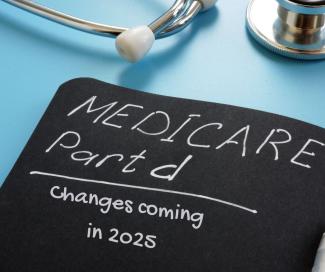
Medicare changes—how will they affect you?
by Michelle Kuehner, ChFC®, CEP®, CRPC®, CEPF®, ADPA®
Last week, the focus was on reviewing your Medicare plan during open enrollment, which takes place between October 15, and December 7.
This week, we will tackle the prescription medication coverage included in your plan. We will also look at the significant changes that are approaching for Medicare Part D and Advantage plans in 2025.
Individuals covered by Medicare should receive their Annual Notice of Change by September 30 each year. This notice (often referred to as the ANOC) provides information regarding changes to premiums, co-pays, and benefits for Medicare Part D and Advantage plans for the upcoming year. This offers a great chance to get familiar with plan changes before the start of Medicare's Open Enrollment Period.
One notable change resulting from the Inflation Reduction Act will be implemented in January, when seniors enrolled in Medicare will enjoy a $2,000 cap on annual out-of-pocket costs for prescription medications.
This is excellent news for individuals facing significant prescription drug costs annually, particularly for those who must decide between affording their medication or covering essential expenses like food and utility bills. Nonetheless, there are a few important points to keep in mind before celebrating with confetti and balloons. To begin, the number of people who are affected by the spending cap is significantly lower than you might think. The remaining seniors who receive Medicare benefits are under the cap. What impact will this change have on them?
Once an individual reaches $2,000 in covered prescription costs, their medication does not magically become free. Someone covers those costs. Medicare assumes that insurance companies will cover 60% of the costs once the $2,000 limit is surpassed; however, it is important to remember that insurance companies operate as businesses, not charitable organizations. These expenses are likely to be passed on to consumers in the form of higher premiums, and the exclusion of specific medications. Even medications that you are presently taking and have coverage for may no longer be covered. Additionally, if your prescription is not on the covered list, the spending limit will not apply.
Most Medicare drug plans have their own list of covered drugs, known as a formulary. Plans include brand-name and generic medications. At least two medications from the most regularly prescribed categories and classes are on the formulary. This ensures that individuals with various medical issues can get medications they need. Some plans may cover a certain medication for one health condition but not another.
What implications does this have for most individuals enrolled in Medicare Part D and Advantage plans? It is essential to review your plan to ensure that your needs are properly met. To achieve this, you can visit www.Medicare.gov to compare plans. You can add your medications, choose multiple pharmacies, and ensure your prescriptions are covered. It also determines which pharmacy offers the best savings for you.
There are tremendous changes coming to Medicare benefits for 2025. Ensure that you are not taken by surprise and that you receive the most value for your money.

